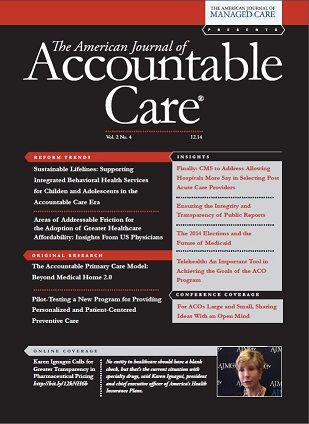Publication
Article
Population Health, Equity & Outcomes
Telehealth: An Important Tool in Achieving the Goals of the ACO Program and Why Restrictions Should Be Lifted in Final ACO Rule
Author(s):
Lifting section 1834(m) restrictions on telehealth services would help ACOs to utilize this beneficial tool to achieve their cost, quality, access, and patient engagement goals.
In the recently released proposed rule related to the accountable care organization (ACO) program1 (or Medicare Shared Savings Program, as it is formally known), the CMS contemplated allowing ACOs to utilize and be reimbursed for an important tool in better coordinating care, engaging patients, delivering services efficiently, and reducing costs: telehealth.
Congress adopted the ACO concept as part of an effort to optimize healthcare delivery by incentivizing Medicare providers to furnish more integrated, better quality, and cost-effective care. Specifically, its stated purpose is to: “promote accountability for a patient population and coordinate items and services under parts A and B, and encourage investment in infrastructure and redesigned care processes for high quality and efficient service delivery.”2 As part of the program, ACOs are required to: “…define processes to promote evidence-based medicine and patient engagement…and coordinate care, such as through the use of telehealth, remote patient monitoring, and other such enabling technologies.”3
In the proposed rule, CMS acknowledged that telehealth “could allow ACOs to realize cost savings and improve care coordination.” They also acknowledged that Congress explicitly cited telehealth as an enabling technology that can assist in the coordination of care.
The challenge for ACOs in adopting telehealth has been section 1834(m) of the Social Security Act, which restricts Medicare reimbursement to a limited number of Medicare Part B services furnished through particular telecommunications systems to only those beneficiaries able to reach an “originating site” located in a rural Health Professional Shortage area or a county outside of a Metropolitan Statistical Area (MSA). Specifically, “originating sites” only include physician offices, hospitals, critical access hospitals, skilled nursing facilities, and Federally Qualified Health Centers (FQHCs).4,5
Telehealth can only be used in facilities in rural areas, which limits the ability of medical providers to reach patients in their homes and communities. As a result, the number of Medicare beneficiaries accessing telehealth is miniscule. According to CMS data analyzed by the Center for Telehealth and eHealth Law, in 2011, CMS spent less than $5 million on telehealth services for seniors.6 This is out of an overall budget of more than $500 billion.
The 1834(m) restrictions create a disincentive for the vast majority of ACO providers—many of whom are located in urban and suburban areas—to use this type of technology, and exclude a broad swath of Medicare beneficiaries from being able to access the benefits of telehealth. ACOs that do not receive reimbursement for telehealth services are faced with the difficult decision of assuming financial risk by providing the care for free. For many physician-led and smaller ACOs, assuming that risk is not financially feasible.
Data shows the consequences of these restrictions. A recent survey of ACOs conducted by Premier, Inc and the eHealth Initiative reports that more than 90% of ACOs have concluded that the cost and return on investment for health IT is a “crippling concern.” This is consistent with additional findings showing that ACOs have low technological capabilities and lack the necessary infrastructure to support connected care. Few respondents reported being able to use secure messaging (38%), phone-based telemedicine (34%), or video-based telemedicine (26%).7
The Affordable Care Act granted the secretary of the department of HHS the authority to waive Medicare requirements as necessary to carry out the implementation of the ACO program. With the proposed rule, CMS opened the door to use of that waiver authority. In fact, they acknowledged they have the authority to waive the restrictions: “A waiver of certain Medicare telehealth requirements could be supported by section 1899(b) (2)(G) of the Act in that is gives the use of enabling technologies, such as telehealth, as an example of a process to coordinate care.”1
The comment period for the proposed rule is 60 days, and we should all respond to CMS’s request for “information from ACOs and other stakeholders about the use of such technologies to coordinate care for assigned beneficiaries.”
The body of evidence demonstrating that telehealth contributes to the achievement of all of the goals set forth by Congress and CMS is extensive. In addition to evidence collected by individual ACOs using telehealth, there is much published literature on the benefits of telehealth in a system of accountability and coordinated care. The Journal of the American Medical Association has published 7 articles just this year on telemedicine, while Health Affairs dedicated its entire February 2014 edition to telemedicine evidence. The Journal for E-Health and Telemedicine is continually publishing studies, including a collection of randomized controlled studies of COPD, CHF, and stroke, 3 conditions very prominent in the Medicare population.
Most of the evidence published to date focuses on cost, quality, and access, exactly what Congress and CMS are trying to impact. The American Telemedicine Association has an excellent synopsis of data demonstrating the positive impact of telehealth on cost and quality.8 Overall, the findings demonstrate that telehealth enables providers to reduce unnecessary in-person care (emergency care and preventable inpatient admissions), while increasing patient access to timely primary care. Telehealth also allows providers to connect patients with appropriate specialists and coordinate care across clinical settings.
Telehealth can and will help ACOs achieve the cost, quality, access, and patient engagement goals they are striving for. It is time to lift the section 1834(m) restrictions on the coverage and reimbursement of telehealth services so ACO providers can have another important tool in realizing the new care delivery models envisioned.Author Affiliation: Krista Drobac is the executive director, Alliance for Connected Care, and a partner with Sirona Strategies, Washington, DC.
Address correspondence to: Krista Drobac, E-mail: kdrobac@sironastrategies.com.REFERENCES
1. CMS, HHS. Medicare Program; Medicare Shared Savings Program: Accountable Care Organizations. Proposed Rule. 42 CFR Part 425. Page 231. http://www.ofr.gov/OFRUpload/OFRData/2014-28388_PI.pdf.
2. The Public Health and Welfare. 42 USC. Page 3260, SEC. 1395jjj(a)(1), Shared savings program. http://www.gpo.gov/fdsys/pkg/USCODE-2010-title42/pdf/USCODE-2010-title42-chap7-subchapXVIII-partE-sec1395jjj.pdf.
3. The Public Health and Welfare. 42 USC. Page 3261, SEC. 1395jjj(b)(2)(G), Shared savings program. http://www.gpo.gov/fdsys/pkg/USCODE-2010-title42/pdf/USCODE-2010-title42-chap7-subchapXVIII-partE-sec1395jjj.pdf.
4. The Public Health and Welfare. 42 USC. Page 2550, SEC. 1395m(m)(4)(C), Shared savings program. http://www.gpo.gov/fdsys/pkg/USCODE-2010-title42/pdf/USCODE-2010-title42-chap7-subchapXVIII-partB-sec1395m.pdf.
5. Centers for Medicare & Medicaid Services, HHS. Page 409, SEC. 410.78(b)(4), Telehealth services. 42 CFR. http://www.gpo.gov/fdsys/pkg/USCODE-2010-title42/pdf/USCODE-2010-title42-chap7-subchapXVIII-partB-sec1395m.pdf.
6. Sprang R. How much does Medicare reimburse for telehealth? the real story. CTeL website. http://ctel.org/2012/09/how-much-does-medicare-reimburse-fortelehealth-%E2%80%94-the-real-story/. Published September 7, 2012.
7. eHealth Initiative (eHI) and Premier, Inc. The landscape of accountable care and connected health: results from 2014 national survey of accountable care organizations. http://www.ehidc.org/resource-center/surveys/doc_download/451-survey-the-landscape-of-accountable-care-and-connected-health-results-fromthe-2014-national-survey-of-accountable-care-organizations. Published September 2014.
8. Examples of research outcomes: telemedicine’s impact on healthcare cost and quality. American Telemedicine Association website. http://www.americantelemed.org/docs/default-source/policy/examples-of-research-outcomes---telemedicine'simpact-on-healthcare-cost-and-quality.pdf. Published April 2013.







